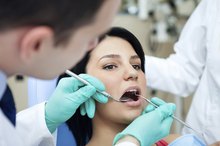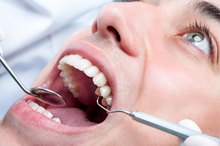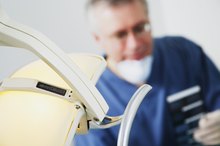Can I Exercise After I Get Treated for Dry Socket?
Tooth extractions don't just mean extra time at your dentist's office and a painful recovery. They also pose a frustrating but necessary interruption to your exercise routine. If your post-extraction discomfort suddenly increases just as you're reaching the end of your enforced inactivity period, don't panic. Yes, dry socket means another trip to the dentist's, but it probably won't delay your return to an active lifestyle.
Definition
Alveolar osteitis, more commonly known as dry socket, is a complication that can occur after your tooth extraction. The phrase refers to a scenario in which the blood clot that should form inside your tooth socket either does not occur at all, becomes dislodged or dissolves too soon. The lack of blood clot exposes bone and nerves, thereby delaying the healing process, opening the site to infection and causing intense pain.
- Alveolar osteitis, more commonly known as dry socket, is a complication that can occur after your tooth extraction.
- The phrase refers to a scenario in which the blood clot that should form inside your tooth socket either does not occur at all, becomes dislodged or dissolves too soon.
Treatment
Dental Extraction Side Effects
Learn More
Dry socket isn't, strictly speaking, a treatable condition. It will pass on its own as the extraction site heals. Medical response to dry socket consists mainly of pain relief and infection prevention. First, your dentist will flush out the socket to ensure no food or other debris remains. Next, she will apply a medicated dressing that counters the pain while it blocks bone and nerve from exposure. You'll probably begin to experience some pain relief within a few hours.
- Dry socket isn't, strictly speaking, a treatable condition.
- First, your dentist will flush out the socket to ensure no food or other debris remains.
Aftercare
You might need to return to your dentist every few days for dressing changes and evaluation until the problem is resolved. After dressings are no longer required, your dentist will give you instructions on how, and for how long, to rinse out the socket yourself at home. You might also need to take prescription pain relievers.
Exercise Considerations
Pain Relief for Wisdom Teeth Removal
Learn More
Restrictions on exercise have more to do with tooth extraction aftercare than with dry socket treatment. Vigorous activity could dislodge the blood clot from the extraction site. This is no longer a concern in the case of dry socket because no blood clot exists to dislodge. Protecting the medicated dressing from being immersed or washed away may restrict swimming activity. Any pain medication your dentist prescribes during dry socket treatment can cause dizziness and similar side-effects. This might contraindicate some forms of exercise, such as running, bicycling, swimming or operating weight machines. You might instead participate with caution in gentle forms of exercise where falling down is not a risk. Tell your dentist about any exercise plan you have in mind so that she can best advise you against unnecessary risk.
- Restrictions on exercise have more to do with tooth extraction aftercare than with dry socket treatment.
- Protecting the medicated dressing from being immersed or washed away may restrict swimming activity.
Related Articles
Writer Bio
Nicole LeBoeuf-Little is a freelancer from New Orleans, writing professionally since 1994. Recent short stories appear on Ideomancer.com and in Ellen Datlow's anthology "Blood and Other Cravings." She has published articles in "Pangaia Magazine" and eGuides at StyleCareer.com. She holds a Bachelor of Arts in English from University of Washington and attended the professional SF/F workshop Viable Paradise.








